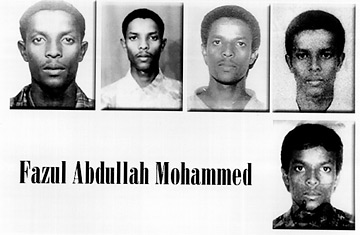
Fazul Abdullah Mohammed, a suspected terrorist wanted in connection with the 1998 bombings of the United States Embassies Tanzania and Nairobi, is shown in a photo released by the FBI.
The portrait of Mohammed that emerges from U.S. intelligence sources and courtroom documents suggests he was personally groomed by Osama bin Laden, and was one of the key planners of the 1998 simultaneous bombing of two U.S. embassies in East Africa. On the morning of August 7, 1998, he drove the lead truck to the embassy in Nairobi, Kenya. The resulting blast killed 224 including 12 Americans. Mohammed, who had been responsible for the basic logistics of the attack, such as renting the apartment to mix explosives and having it cleaned, escaped to his native Comoros Islands off the coast of Mozambique.
Bolstered by the success of his role in the embassy bombings, Mohammed remained in Africa and is believed to have become a leader of al-Qaeda's operations in Somalia, say officials. "It is a very significant event if he's been captured or killed," says Mary Jo White, former U.S. Attorney for the Southern District of New York, who indicted Mohammed along with Osama bin Laden and 19 others in absentia in 2000 for the embassy bombings. "He's close to top leadership of al-Qaeda."
He worked his way up into bin Laden's circle from the bottom. Mohammed was a teenager when he started down the jihadi path, leaving his family home in the impoverished Comoros at age 16 to study on a Saudi-sponsored scholarship at a religious school in Pakistan. Within a year, in 1991, he was training at an al-Qaeda camp in Afghanistan, learning urban warfare and counter-surveillance tactics. In 1993, when Osama bin Laden turned his attention to Africa, Mohammed was sent to Somalia to train local tribesmen to fight the United Nations intervention there.
He soon established himself as a guy who could get things done for bin Laden. According to the U.S. indictment, he hid sensitive papers for operatives, hand-delivered cash from Bin Laden to other parts of Africa and, in May 1996, traveled to Lake Victoria to investigate the death of an al-Qaeda military commander who died in a ferry accident, with instructions to report back directly to bin Laden.
After his indictment in 2000, says White, the U.S. government hoped to capture Mohammed alive, believing he could provide valuable information on al-Qaeda's structure in Africa. There were a "few times," says White, between 2000 and 2002 when "we had pretty good leads, but he escaped."
With his decade-long connections to Somali tribes, Mohammed is believed to have been al-Qaeda's key liaison with the Islamic Courts Union, which took control of Mogadishu and much of Somalia in the summer, but which was recently scattered by an Ethiopian invasion. The Pentagon is not confirming if Mohammed's body has been identified after the strike. "If he's dead, I'm glad," said an an official of the FBI, which lists Mohammed as one of its most wanted terrorists.
"He is an important person to capture or kill," says White, "for the vindication of the victims" of the embassy bombings. His death, says White, would mean "taking out of circulation someone who is very dangerous to have walking around in the world."
